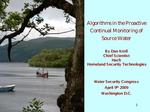Description
The American Water System is made up of American Water Works Company water utility subsidiaries, plus other non-utility subsidiaries, which perform such services as contract operation of water or wastewater treatment plants, and custom reactivation of granular carbon. The wholly owned water utility subsidiaries are aggressively pursuing the standards set for the Partnership for Safe Water, the voluntary cooperative effort between the US Environmental Protection Agency, American Water Works Association, ASDWA, and other drinking water organizations, with over 186 surface water utilities representing 245 treatment plants throughout the United States. The American Water System believes it is the reaponsible corporate action for a utility to take. Sixty-six percent of the water produced by American Water System utility subsidiaries comes from surface water sources. The Partnership’s goal is to provide a new measure of safety to millions of US consumers by implementing prevention programs where legislation or regulation does not exist. This paper discusses the value of the Partnership and the benefits of communicating that value. of this research was to assess the competitive adsorption mechanism between atrazine and three dyes of increasing molecular size, and to eliminate the difficulties encountered when using natural organic matter. Phenolic resin-based activated carbon filters (ACFs) received as twilled weave fabrics were used in adsorption experiments. These were designated ACF-10, ACF-20 and ACF-25 in order of increasing activation and pore size heterogeneity. The ACFs were cut into small pieces, dried at 105C, and stored in a dessicator to minimize moisture contact and possible oxidation. The target micropollutant chosen for this study was the pesticide, atrazine. To facilitate rapid and accurate analysis of low atrazine concentrations, C-labelled atrazine was used. Samples were prepared by mixing 2.5 mL aliquots of 0.22 um filtered sample with 18 mL of scintillation cocktail and analyzing the resultant fluorescence with a scintillation counter. The specific activity of C-atrazine batches varied from 56.3 uCi/mg to 38.7 uCi/mg. Based on this, the limit of detection for 95 percent confidence varied between 0.05-0.10 ug/L. Three dyes of increasing molecular size were used as competing adsorbates: Methylene Blue (MB), Malachite Green (MG) and Congo Red (CR). Dye concentrations were quantified by visible spectrophotometry at wavelengths 661nm, 617nm and 497nm for MB, MG and CR, respectively. The limit of detection was approximately 0.1 uM. The adsorption study consisted of the following 7 day isotherm tests: single solute adsorption of atrazine and each of the dyes in deionized-distilled water (DDW), simultaneous adsorption of atrazine with each dye, dye preloading followed by atrazine adsorption, and atrazine preloading followed by dye contact.
Product Details
- Published:
- 01/01/1999
- ISBN(s):
- 1583210016
- Number of Pages:
- 4
- File Size:
- 1 file , 150 KB
- Note:
- This product is unavailable in Ukraine, Russia, Belarus





